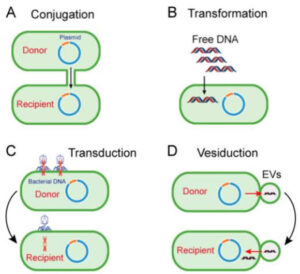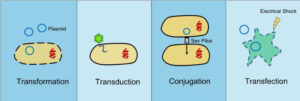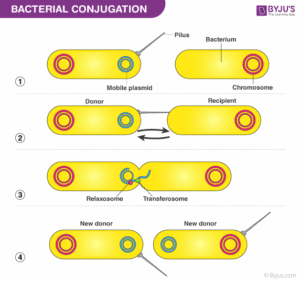Back to: MICROBIOLOGY 200 LEVEL
Welcome to class!
Hello there, superstar! It’s always a pleasure to see your commitment to learning. Today’s lesson is a really exciting one — it’s like learning the secret methods bacteria use to “talk”, “share” and “help each other grow stronger.” Yes, we’re looking at Transformation, Transduction, and Conjugation — three special ways bacteria exchange genetic information.
Transformation, Transduction, And Conjugation
Have you ever seen students in a hostel sharing handouts, lending textbooks, or passing along exam tips? That’s similar to what bacteria do with DNA. Unlike humans who inherit genes only from parents, bacteria can get new genes from their environment or even from other bacteria around them. This helps them adapt, survive, and sometimes become stronger — for example, gaining resistance to antibiotics.

Let’s look at the three major methods: transformation, transduction, and conjugation.
Transformation
This is when a bacterium takes in free DNA from its surroundings.
Think of it like a student picking up a forgotten notebook someone left behind and learning new information from it.
How it happens:
When bacteria die, they break open and release their DNA.
Other bacteria nearby can pick up this DNA and insert it into their own genome.
Not all bacteria can do this; only those that are competent (naturally or through lab treatment).
Why it matters:
It’s one of the ways bacteria adapt to new environments.
Scientists also use transformation to insert new genes into bacteria in the lab.
Transduction
This involves viruses (bacteriophages) transferring DNA from one bacterium to another.
Picture a delivery man who accidentally picks up someone else’s package and delivers it to the wrong person.

How it works:
A virus infects a bacterium and accidentally carries some of its DNA.
When the virus infects another bacterium, it delivers that DNA into the new host.
Why it matters:
It’s a way bacteria gain new traits, including resistance or toxin production.
It’s also used in genetic research and biotechnology.
Conjugation
This is the direct transfer of DNA from one bacterium to another through a physical connection.
It’s like two students passing notes under the table using a string and peg.
How it works:
A bacterium with a fertility (F) plasmid builds a bridge-like structure called a pilus.

DNA, usually in the form of a plasmid, is transferred through this pilus to the other cell.
Why it matters:
It’s the most common method bacteria use to spread antibiotic resistance.
It’s also useful in genetic engineering and biotechnology.
Summary
- Transformation is when bacteria absorb DNA from their surroundings.
- Transduction is the transfer of DNA by viruses (bacteriophages).
- Conjugation involves direct DNA transfer between bacteria through a pilus.
- All three processes help bacteria gain new traits and survive better.
- These processes are widely used in scientific research and genetic engineering.
Evaluation
- What is bacterial transformation and how does it occur?
- Explain how transduction works using bacteriophages.
- What is the role of the F plasmid in conjugation?
- Which of these processes involves a pilus?
- Give a real-life reason why bacterial DNA exchange is important in medicine or agriculture.
Well done! You’ve just uncovered how bacteria share information to become stronger and smarter — and how scientists use those same tricks to improve health and technology. Keep going strong; your future in microbiology is looking incredibly bright. Let’s meet again in the next class.
